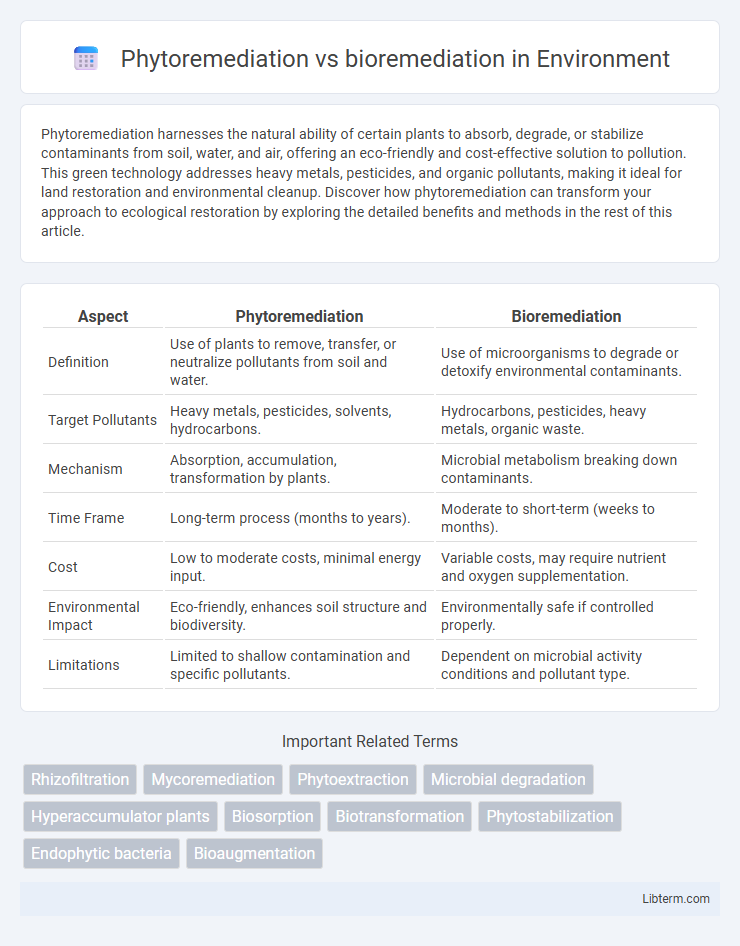Phytoremediation harnesses the natural ability of certain plants to absorb, degrade, or stabilize contaminants from soil, water, and air, offering an eco-friendly and cost-effective solution to pollution. This green technology addresses heavy metals, pesticides, and organic pollutants, making it ideal for land restoration and environmental cleanup. Discover how phytoremediation can transform your approach to ecological restoration by exploring the detailed benefits and methods in the rest of this article.
Table of Comparison
| Aspect | Phytoremediation | Bioremediation |
|---|---|---|
| Definition | Use of plants to remove, transfer, or neutralize pollutants from soil and water. | Use of microorganisms to degrade or detoxify environmental contaminants. |
| Target Pollutants | Heavy metals, pesticides, solvents, hydrocarbons. | Hydrocarbons, pesticides, heavy metals, organic waste. |
| Mechanism | Absorption, accumulation, transformation by plants. | Microbial metabolism breaking down contaminants. |
| Time Frame | Long-term process (months to years). | Moderate to short-term (weeks to months). |
| Cost | Low to moderate costs, minimal energy input. | Variable costs, may require nutrient and oxygen supplementation. |
| Environmental Impact | Eco-friendly, enhances soil structure and biodiversity. | Environmentally safe if controlled properly. |
| Limitations | Limited to shallow contamination and specific pollutants. | Dependent on microbial activity conditions and pollutant type. |
Introduction to Environmental Remediation
Phytoremediation and bioremediation are two vital environmental remediation strategies that leverage natural biological processes to clean contaminated sites. Phytoremediation utilizes plants to absorb, degrade, or stabilize pollutants in soil, water, and air, while bioremediation employs microorganisms such as bacteria and fungi to break down hazardous substances into less toxic forms. These methods offer sustainable, cost-effective alternatives to traditional physical or chemical remediation techniques by promoting in-situ treatment and reducing environmental impact.
Defining Bioremediation: Processes and Applications
Bioremediation involves the use of microorganisms, such as bacteria and fungi, to degrade or detoxify pollutants in soil, water, and air, effectively restoring contaminated environments. This biological process relies on microbial metabolism to break down hazardous substances, including petroleum hydrocarbons, heavy metals, and organic compounds, transforming them into less harmful or inert forms. Applications of bioremediation span oil spill treatment, wastewater purification, and industrial waste management, making it a versatile and eco-friendly approach for environmental remediation.
What is Phytoremediation? Mechanisms and Methods
Phytoremediation is an eco-friendly technique that uses plants to remove, stabilize, or degrade contaminants from soil, water, and air. The primary mechanisms include phytoextraction, where plants absorb heavy metals; phytodegradation, involving plant enzymes breaking down pollutants; and rhizofiltration, which employs roots to filter toxins from water. Effective methods for phytoremediation include selecting hyperaccumulator species and optimizing growth conditions to enhance contaminant uptake and degradation.
Types of Bioremediation Techniques
Bioremediation techniques include in situ methods such as bioaugmentation, where specific microorganisms are added to contaminated sites, and biostimulation, which involves enhancing the growth of native microbes through nutrient addition. Ex situ techniques like biopiling, landfarming, and bioreactors treat contaminated soils or waste by optimizing microbial activity under controlled conditions. Phytoremediation, a subset of bioremediation, uses plants to absorb, degrade, or stabilize pollutants, but bioremediation encompasses a broader range of microbial-based approaches targeting diverse contaminants.
Phytoremediation Approaches and Plant Selection
Phytoremediation approaches include phytoextraction, phytodegradation, phytostabilization, and phytovolatilization, each targeting specific contaminants through plant uptake, degradation, or stabilization mechanisms. Selecting appropriate plants such as hyperaccumulators like Brassica juncea for heavy metals, Populus species for organic pollutants, and Vetiver grass for soil stabilization is crucial for maximizing remediation efficiency. Plant traits including root depth, biomass production, and tolerance to contaminants directly influence the success of phytoremediation projects in diverse environmental conditions.
Comparative Analysis: Phytoremediation vs Bioremediation
Phytoremediation utilizes plants to absorb, accumulate, and detoxify contaminants from soil and water, making it cost-effective and environmentally friendly but slower compared to bioremediation. Bioremediation employs microorganisms to degrade organic pollutants, offering faster degradation rates and suitability for a wider range of contaminants, including petroleum hydrocarbons and heavy metals. The selection between phytoremediation and bioremediation depends on site-specific factors such as contaminant type, concentration, and environmental conditions, with phytoremediation favored for shallow, low-to-moderate contamination and bioremediation for more complex or high-level pollution.
Key Benefits of Phytoremediation
Phytoremediation offers significant advantages such as cost-effectiveness, utilizing plants to extract, stabilize, or degrade contaminants without heavy machinery or chemical treatments. It enhances soil health by promoting natural microbial activity and preventing erosion through root systems. This green technology also supports habitat restoration and carbon sequestration, making it an environmentally sustainable approach to pollution management compared to conventional bioremediation techniques.
Major Advantages of Bioremediation
Bioremediation offers major advantages such as cost-effectiveness and the ability to treat a wide range of contaminants including hydrocarbons, heavy metals, and pesticides through the metabolic activities of microorganisms. This method harnesses natural microbial processes to degrade pollutants into non-toxic compounds, enabling in situ treatment that minimizes environmental disturbance. Its scalability and applicability to diverse environments from soil to groundwater make bioremediation a versatile and sustainable solution for environmental cleanup.
Challenges and Limitations of Each Method
Phytoremediation faces challenges such as slow contaminant removal rates, limited plant tolerance to toxic pollutants, and soil depth constraints affecting root reach. Bioremediation is limited by the specific microbial strains' effectiveness, potential accumulation of toxic byproducts, and dependency on optimal environmental conditions like temperature, pH, and nutrient availability. Both methods require careful site assessment and monitoring to overcome these limitations for successful pollutant degradation.
Future Perspectives in Ecological Remediation
Phytoremediation harnesses plants' natural ability to absorb, degrade, or stabilize contaminants, making it a cost-effective and sustainable solution with expanding applications in heavy metal and organic pollutant cleanup. Bioremediation employs microorganisms to metabolize hazardous substances, showing promise in treating complex chemical mixtures and emerging contaminants through genetic engineering advancements. Future perspectives emphasize integrating phytoremediation and bioremediation techniques with nanotechnology and AI-driven monitoring to enhance efficiency, scalability, and real-time assessment in ecological restoration projects.
Phytoremediation Infographic

 libterm.com
libterm.com